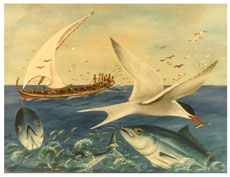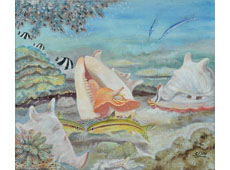Sarudhaaru Dhon Maniku, who often signs his paintings SDM, is considered the pioneer of ‘souvenir art’, or art and craft produced with the primary purpose of selling or gifting it to a tourist.
Also one of the first Maldivians to scuba dive, SDM’s imagination is infused with the colors and rich and varied life forms of the underwater world. The son of a craftsman, SDM was initiated into the trade of craft making and art at an early age. Commissioned by various friends and others, SDM initially produced various gift and craft items. Later on, he was commissioned to produce portraits or copy printed images by the Indian (Bhora) traders who were stationed in Male from the late 1800s until mid 20th century.
SDM was first noticed for his talent and skills during the 10 year period beginning from the end of the reign of Sultan Hassan Noordeen, and the formation of the first republic in 1953 with Mohamed Amin Didi as the first president.
 SDM was then a teenager. He recalls President Amin Didi as a great patron of the arts and crafts, and indeed it was he who organised a nationwide arts and crafts fair in the capital for the first time in the history of the country. More generally, the short tenure of Amin Didi’s presidency is also regarded as a period of literary and cultural renaissance.
SDM was then a teenager. He recalls President Amin Didi as a great patron of the arts and crafts, and indeed it was he who organised a nationwide arts and crafts fair in the capital for the first time in the history of the country. More generally, the short tenure of Amin Didi’s presidency is also regarded as a period of literary and cultural renaissance.
Even though SDM was noticed for his talents at an early age and in the 1940s and ‘50s, he says it was the advent of tourism in the early1970s that really helped him to carve out a profession in which he could dedicate his skills as an artist and craftsman fully to his profession. The ‘tourist market’, as it became later known, proved to be a lucrative avenue for all aspiring craftsmen, artisans and hopeful artists in the country, and given the rich traditions of craft in the Maldives, this was a welcome development for the country at large.
In the 1980’s more than 20 highly developed craft forms were documented. These ranged from coir rope-making from coconut husk, to weaving mats from a variety of dried grass and then coloring it with natural dies, to intricate and exquisite looking lacquer ware and expensive jewellery made from gold and silver.
By coincidence, the year SDM was born was also the year the French Impressionist painter Monet died. And during the course of SDM’s life, Europe experienced the trends of Modernism, DADA, Surrealism, Abstract Expressionism, Pop and Post-Modernist art.
While it may be futile to interpret SDM’s works through the prisms of these aesthetic and stylistic trends, it’s interesting to note that SDM’s works exhibit many qualities of these very trends of which he may never have known about first hand.

Perhaps more importantly, SDM admits he always strived to make something that maybe of use; admiration of aesthetical beauty being one of these uses. Additionally, he also meticulously documented the shells and fishes commonly found in the Maldivian reefs and lagoons. One of the first series of posters depicting shells and fishes of the Maldives was illustrated by SDM, which is still in print and published by Novelty Printers and Publishers Maldives.
Apart from the sheer output of his work over a period of several decades (SDM is now in his late eighties), what is most apparent in SDM’s long career are the different media he has mastered over time. This includes the pencil, water, acrylic and oil colors as well as sculpting and carving. In addition to this, he has also consistently demonstrated a knack for invention, often experimenting with different materials and techniques, and continuing even today. Senior Maldives artist Ahmed Abbas has commented on SDM; “Dhonbe is a great artist, especially his underwater scenes have something special and great about them. He has applied color to great effect. Even when we were kids, Dhonbe was a renowned artist .”
In recognition of SDM’s contribution to Maldivian culture and to celebrate his achievements in the arts, the National Art Gallery of the Maldives commissioned him in 2005 to produce a series of works for the permanent collection of the gallery. Some of these works are also now exhibited in the Maldivian Ministry of Foreign Affairs and Maldivian embassies abroad, and others are displayed at the gallery in temporary exhibitions.
The Gallery also commissioned a book documenting the life of SDM which was published in 2009 in Dhivehi, and an English translation is due to be published in 2012.
 SDM lives at his home in Male and continues to produce paintings, handcrafted objects and other items such as hand painted greeting cards and says he is very content with the life he has lived. He continues to be an inspiration to younger generations of artists and is one of the most prized individuals in the country.
SDM lives at his home in Male and continues to produce paintings, handcrafted objects and other items such as hand painted greeting cards and says he is very content with the life he has lived. He continues to be an inspiration to younger generations of artists and is one of the most prized individuals in the country.
Mamduh Waheed is Deputy Minister for Tourism Arts and Culture. He is also a writer on Maldivian art and has written several reviews and essays for catalogs, and was curator of the National Art Gallery from 2004 to 2009.
